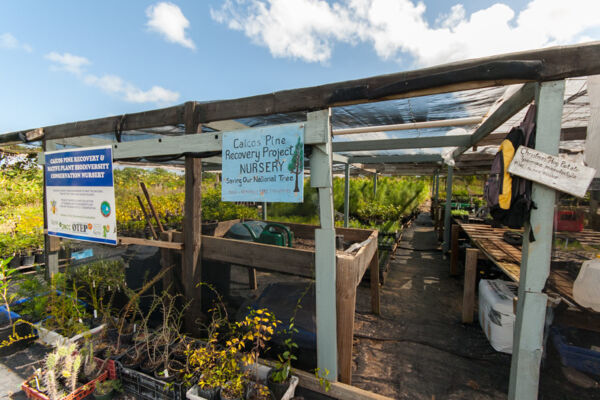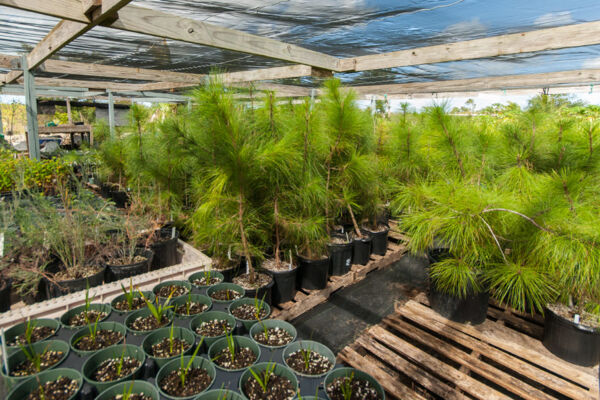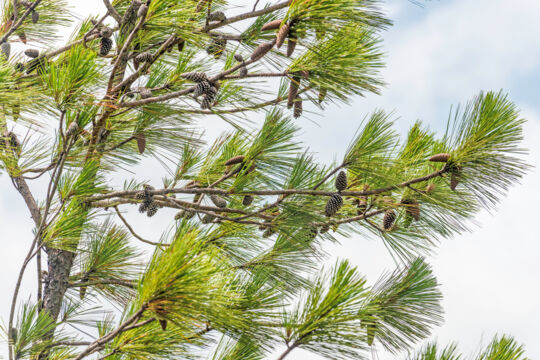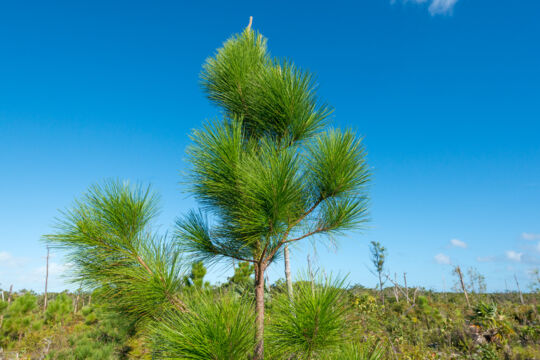Caicos Pine Yard Trail
Old King's Road, Middle Caicos
Located on the extensive and low-lying brushlands of Middle Caicos, the Caicos Pine Yard Trail is a tranquil and scenic 0.5-mile (0.8 km) nature walk and the best place in the country to see the national tree of the Turks and Caicos—the local variety of the threatened Caribbean pine (Pinus caribaea var. bahamensis).
A unique and beautiful terrain surrounds this short trail. Along with the pines, majestic sabal palms, West Indian mahogany, sawgrass, and thatch palms are abundant.
The environment shelters many types of birds, including the bananaquit, Bahamas woodstar hummingbird, ani, Cuban crow, and more. More often heard than seen, giant blue land crabs also scurry through the underbrush.
Mosquitoes can be quite annoying here at times. Consider taking appropriate repellent when visiting. Rain can cause the hiking trail to become quite muddy in places, so wear suitable hiking or walking footwear. Watch out for the toxic coral sumac tree.
The Caicos Pine
Found only on a few Turks and Caicos and Bahamian islands, the Caicos pine requires a specific environment to live and thrive. While they need a constant and relatively salt-free source of water, the trees can’t sustain deep and prolonged flooding. Because of these requirements, all of the country’s pines are found only on the inland flats of North Caicos and Middle Caicos, as well as on Pine Cay.
The Turks Islands of Grand Turk, Salt Cay, and South Caicos do not have suitable low-salinity wetlands. Thus, they have no Caicos pines.
Providenciales does have an interior region in the Frenchman’s Creek Nature Reserve that could likely support the Caicos pine. However, either the Caicos pine was never established in the area, or logging took place in previous centuries and wiped out the tree.
Other Non-Native Pines
Two other varieties of tree in the Turks and Caicos are sometimes mistaken for the indigenous Caicos pine.
The casuarina (also known as the Australian pine) is common to many beaches and coasts in the country. Casuarina is not a true pine, and this invasive plant has taken over the dune vegetation on several local coasts, notably Cedar Point and Wild Cow Run (on Middle Caicos) and Pine Cay and Joe Grant Cay. While casuarina previously grew rampantly on Half Moon Bay Beach, a large-scale conservation project has removed nearly all of the casuarina from the area.
An introduced species and rare throughout the country, the distinct and highly symmetrical Norfolk Island pine was once a popular landscaping choice on Providenciales and Pine Cay in past decades. It’s a beautiful tree, and mature examples of this evergreen often tower over the surrounding vegetation, especially on older properties.
Pine Tortoise Scale & Forest Die-Offs

Unfortunately, many of the Caicos pine forests are experiencing severe attacks and die-offs from an introduced pest—the Pine tortoise scale insect.
It’s thought that this insect was introduced via imported Christmas trees. The threat from this scale insect has spread across the main islands in the country. Several approaches are being taken to counterbalance the disease that threatens the pine.
A few strains of the Caicos pine have exhibited resistance to the scale, and large numbers of seedlings from these trees are being grown at the Government Farm in Kew on North Caicos.
On Pine Cay, seedlings have been transplanted back to the original environment and appear to be doing well—a welcome glimmer in the dim outlook for the pine.
Controlled burns have also taken place, and these actions are meant to mimic naturally occurring fires that reduce competing plants and trees and may also fight scale insects.
The Caicos Pine Recovery Project, assisted by the UK Royal Botanic Gardens at Kew and the local Department of Environment and Maritime Affairs (DEMA), is overseeing the crucial recovery of the pines, with good results. Caicos pines are just one area of focus for international environmental groups.
Getting to the Caicos Pine Yard Trail

Although a bit out of the way, the Caicos Pine Yard is rather easy to locate. Both Conch Bar Caves and the defunct Middle Caicos Airport are situated close by.
When driving into Middle Caicos from the causeway, you’ll eventually reach the Pine Yard if you continue straight for about 5.5 miles (8.9 km). You should pass the turn for Mudjin Harbour and Dragon Cay Resort, the junction with Conch Bar Village, the small power substation, the Middle Caicos Airport (MDS), and—finally—the caves. The final 1.5 miles (2.5 km) of this route are unpaved.
The site is currently free to access. There are no bathrooms or facilities present.



